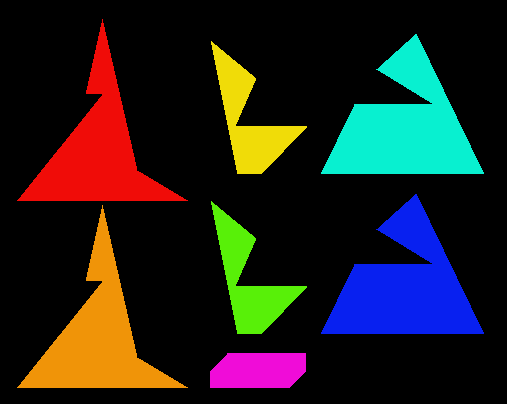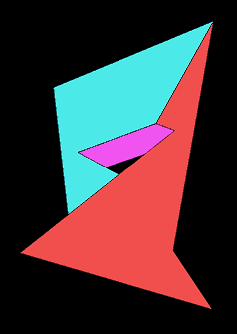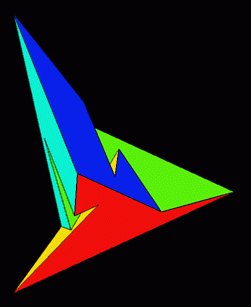
the Szilassi polyhedron
In 1977, Hungarian mathematician
Lajos Szilassi
found a way to construct a toroidal heptahedron. Each face of his
polyhedron is a hexagon (although none of them is a regular hexagon).
To make your very own model of a Szilassi polyhedron, click
here
to download a pattern in PDF (52807 bytes, viewable with the free
Adobe® Acrobat® reader
). For aesthetic reasons, I've altered the polyhedron's angles and
proportions slightly from Szilassi's originals.
Click
here
for Dr. George Hart's tips on constructing paper polyhedron models.
(And if you make a polyhedron with this pattern, feel free to let me
know how it came out. I'm happy to hear from people who've checked
out this web page.)
The Szilassi polyhedron shares
with the tetrahedron the property that each of its faces touches all
the other faces. A tetrahedron demonstrates that four colors are
necessary for a map on a surface topologically equivalent to a sphere;
the Szilassi polyhedron demonstrates that seven colors are necessary
for a map on a surface topologically equivalent to a torus. (Neither
demonstrates anything about how many colors are sufficient.)
The vital statistics of the two polyhedra are as follows:
| tetrahedron | 4 faces | 4 vertices | 6 edges | 0 holes |
|---|---|---|---|---|
| Szilassi polyhedron | 7 faces | 14 vertices | 21 edges | 1 hole |
What other kinds of polyhedra could have the property that each pair
of faces shares an edge? Maybe none.
Euler's formula f + v - e = 2
is easily generalized for polyhedra with holes;
if h is the
number of holes, f + v - e = 2 - 2*h .
In a polyhedron every pair of whose faces shares an edge,
f and e are
related by the equation e = f * (f - 1) / 2.
Each vertex
must be at the intersection of three edges. (If there were more than
three, some pairs of faces couldn't share an edge.) Thus, as each edge
connects two vertices, v = e * 2 / 3.
Combining the above equations and simplifying gives
h = (f*f - 7*f + 12) / 12
which can be factored as
h = (f - 4) * (f - 3) / 12
. Only certain values of f yield whole numbers of
holes. f=4 applies
to the tetrahedron; f=7 applies to
the Szilassi polyhedron. The next
value of f that yields a whole value for h is
12, which would apply to
a polyhedron with 12 faces, 66 edges, 44 vertices, and 6 holes. That
configuration doesn't sound workable to me; higher
values of f and h
seem even less likely. Obviously I'm a bit short of a proof,
but you get the picture.
Click
here
to see a model of the configuration of the dual of such an unlikely
polyhedron.
Szilassi gave a set of equations that describe a particular instance of a
7-sided toroidal polyhedron; Martin Gardner reproduced patterns for the
faces (in the context of an entertaining discussion about math and minimalist
art) in his Mathematical Games column in Scientific American (Nov. 1978).
Szilassi's seven faces, in their original shapes, are also illustrated below.
There is a dual to the Szilassi polyhedron. It was discovered in the
late 1940s by Ákos Császár and has 14 triangular faces,
7 vertices, 21 edges, and one hole. Patterns for a model of the
Császár polyhedron can be found in Martin Gardner's column in
the May 1975 Scientific American. (The math above was adapted from
Gardner's description of Donald W. Crowe's analysis of the relationships
among f, v, e, and h in
the Császár polyhedron.)
There's an applet at
http://mathworld.wolfram.com/SzilassiPolyhedron.html
that shows how the Szilassi polyhedron looks at various rotations that you
can control with your cursor. (Last I checked, the Java code in that
applet exhibited a bug in its hidden-surface removal methods; the polyhedron
isn't rendered properly at certain rotations. The bug isn't a big deal;
I found it more amusing than annoying.)
Images on this page were generated by a program I wrote to play with
altering the angles and proportions of the polyhedron.
To download C++ source and documentation for the program (gzipped
tarball, 44379 bytes; requires X Window graphics), click
here.
If you'd like further information, send me email.
Tom Ace
return to Tom's home page
Click here
for a Hungarian language version of this page
(translated by Noémi Vanderstein).
The polyhedron's seven faces:

Other views of the polyhedron in perspective:

|

|